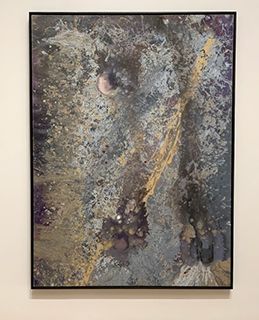Frank Bowling: Part Two
By the end of the 1970s, Frank Bowling was fully in control of the painting techniques he had spent the last ten years fine-tuning.
He had a deep understanding of the dynamics of the flow of paint and the drama of
colour combination.
We will now continue to view Bowling's paintings through the Rooms as presented at the exhibition I attended at the Tate Britain a few weeks ago.
All images unless otherwise stated are from my own photographs.

Room Five: Cosmic Space
The way Frank Bowling was moving forward in his quest for the ultimate creative work was ceretainly unbridled! His experimentation included using ammonia and pearlessence and through applying splotches of paint he achieved a marbling effect. He also embraced accidents. For example, the round imprint of a bucket, left to rest on a drying canvas, contributed to the composition of Vitacress 1981 (below) and became a recurring device.

Room 5 was titled Cosmic Space because the paintings might make us think of atmospheric impressions of skies, visions of the cosmos, or alchemical transformations. It was not however Bowling's intention to create such subject matter but as the Tate Britain Exhibition Booklet states: Bowling welcomes different responses and interpretations from vieweres.
Here are three more paintings from Room 5 and when you see these works in the flesh their impact is amazing.



Room Six:More Land than Landscape
In this room were paintings that showed how Bowling had begun to add to the colour and structure of his images by building up textures on the surface.

The materials used to creative the above painting include: acrylic and oil paint, acrylic gel, damar, beeswax, chalk, metallic pigments, scrylic foam, shells and plastic toys on canvas. However these materials are rarely visiable in the painting as Bowling has expertly blended all into a harmonious composition.
The title of the painting pays homage to the artist R.B. Kitaj who studied with Bowling at the Royal Collage of Art, London.
I could have spent all day in Room 6- the texture and colour in the Bowling images were mind bending. Below you have three more examples. In the first of these paintings (Towards Crab Island):
the action of gravity has played a part in the accidental arrangement of the strips of foam that form its composition. The heavy mixture of paint and gel that was poured over the foam pulled it downwards. Bright and dark colours are juxtaposed to create a strong contrast and a sense of shimmering luminosity.
The title refers to the name of an area located on the bank of the Berbice River, Guyana. Its mangrove forest is still thick, although threatened by plans to create an onshore oil base or deep-water port.



Tomorrow we will conclude our tour of Frank Bowling's World of Art by viewing Rooms, 7, 8 and 9 up very close.
For those of you who use Twitter you might be interested to follow Art in America who go by the handle of @ArtinAmerica.
Gabriel Coxhead reviews Frank Bowling’s delirious conflagrations of form, color, and texture at @Tate Britain https://t.co/3gYEHCrizw pic.twitter.com/5GLyAAoF1z
— Art in America (@ArtinAmerica) September 23, 2019
Credit:
All images unless otherwise stated are from my own photographs. The notes that accompanying the images above have been taken from the Tate Britain Exhibition Booklet.
